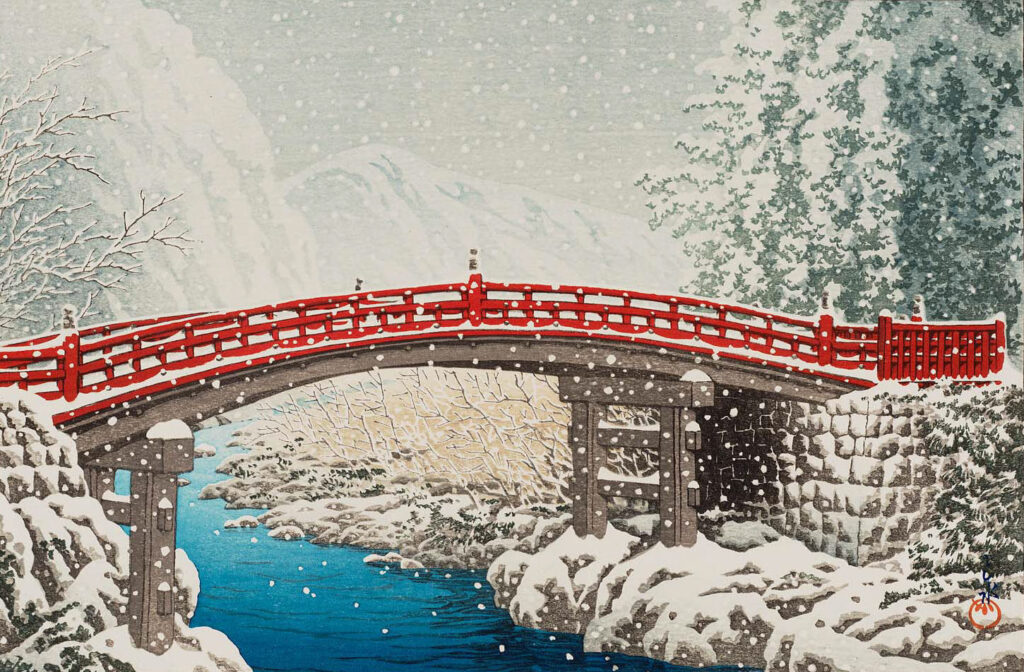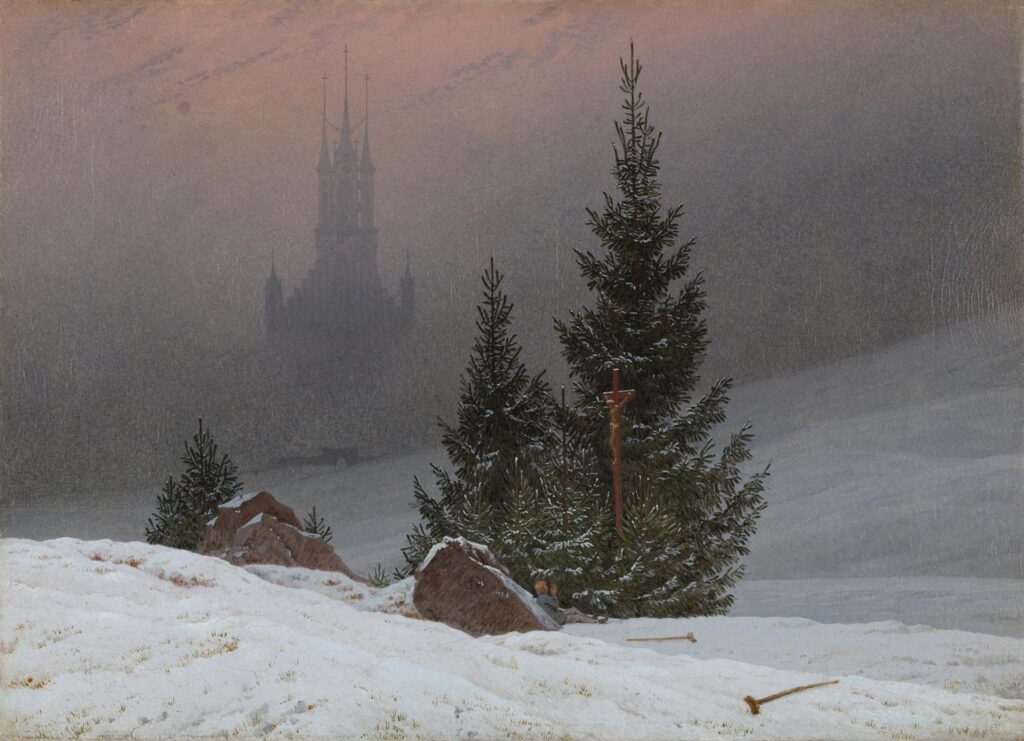10 Iconic Floral Still Lifes You Need to Know
Flowers have long been a central theme in still-life painting. Each flower carries its own symbolism. For example, they can represent innocence,...
Errika Gerakiti 6 February 2025
The quiet beauty and haunting charm of snow-covered landscapes, bare trees, and soft, silvery light create a world of stillness and wonder. Winter’s embrace serves as an exemplary medium for exploring themes of solitude, tranquility, and celebration. From bustling scenes depicting the promise of Christmas to solitary, snow-laden forests, these artworks invite us to pause and appreciate the serene, often overlooked beauty of winter. Here are 10 winter paintings that celebrate snowy weather!

Ivan Fedorovich Choultsé, Winter Morning in Engadine. Christies via Wikimedia Commons (public domain).
Ivan Fedorovich Choultsé, a 19th-century Russian landscape painter, devoted his talent to celebrating the beauty of nature through his art. Known for his serene winter scenes, Choultsé’s paintings captured the essence of snow-covered Swiss landscapes with remarkable attention to light and atmosphere. Preferring to leave his canvases free of humans or animals, he allowed the untouched beauty of nature to take center stage. Through his mastery of depicting light in his widely acclaimed works, Choultsé left a lasting impression on the art world, earning recognition in the Russian art scene.

Hasui Kawase, Snow on the Sacred Bridge at Nikkô, 1930, Museum of Fine Arts, Boston, MA, USA.
Hasui Kawase, an eminent Japanese artist of the Shin Hanga movement, brought landscapes to life with his masterful woodblock prints. Known for his evocative depictions of snow, and rain, Kawase captured the serene beauty of the Shinkyo Bridge at the entrance to the UNESCO World Heritage Site Shrines and Temples of Nikko. In this work, a delicate blanket of snow covers the vivid red bridge, creating a striking contrast against the muted tones of the ethereal winter backdrop. The soft, falling flakes add a gentle sense of movement, highlighting the harmony between the man-made structure and its tranquil natural surroundings.

Ivan Aivazovsky, Winter Landscape, 1876. Artvee.
Ivan Aivazovsky was an accomplished Russian-Armenian painter renowned for his maritime paintings. In this artwork he portrays a serene, snowy countryside bathed in soft, luminescent light, particularly highlighting the snow-covered trees in the foreground. A path cuts through the middle of the scene, featuring several figures engaged in a quiet promenade. While the painting captures the solitary essence of winter, the figures introduce a subtle sense of activity with their distant voices almost tangible within the stillness.

Ivan Shishkin, In the Wild North, 1891, Kyiv National Picture Gallery, Kyiv, Ukraine.
This nocturne by the illustrious Russian landscape painter Ivan Shishkin captures a hauntingly beautiful winter night. Illuminated by bright moonlight, the snow-laden pines stand at the edge of a cliff, evoking a sense of solitude and fierce cold. The absence of life enhances the quiet majesty of the scene, creating a contemplative atmosphere. This work is believed to draw inspiration from Mikhail Lermontov’s 1841 poem The Pine Tree, reflecting its poetic imagery and melancholic tone.
In the wild north a pine tree stands alone
On the bare top of a mountain.
It slumbers and sways, covered with
Powdery snow like a mantle.
And it dreams constantly: that in faraway wilds
In the land where the sun rises,
A cheerless and lovely palm stands alone,
Growing on a gloomy cliff.The Pine Tree

Francisco Goya, The Snowstorm (Winter), 1786, Museo del Prado, Madrid, Spain.
Francisco Goya, a leading figure in Spanish art during the late 18th and early 19th centuries, was known for his unflinching portrayal of life’s darker realities. In this scene, peasants are shown braving the biting cold of winter, their donkey laden with the spoils of a hunting trip. The shooter acknowledges an enthusiastic dog that appears to have accompanied the group, adding a quiet moment of connection amidst the desolation. The three central figures huddle together for warmth against the unforgiving backdrop of the winter season, embodying the resilience demanded by rural life. Goya’s honest depiction captures not only the physical toll of the environment but also the harsh realities of rural existence in 18th-century Spain.

Emile Branchard, Winter Night, 1930s, Museum of Fine Arts, Boston, MA, USA.
Born in New York City in 1881, Emile Branchard’s path to painting was unconventional. In his early years, he worked as a truck driver, longshoreman, and policeman, until contracting tuberculosis at the age of 37 and retiring from manual labor. It was during this period that he picked up his stepfather’s leftover paints and began to explore his artistic talents. In Winter Night, Branchard captures a starry night over the edge of a quiet village blanketed in snow. The rich blues of the sky contrast beautifully with the whites of snowy rooftops and barren trees, evoking the stillness of the landscape.

Gustave Courbet, Village Edge in Winter, ca. 1868, Städel Museum, Frankfurt, Germany.
This work by 19th-century French realist painter Gustave Courbet captures the rugged beauty of his hometown, Ornans, set against the dramatic backdrop of the Jura Mountains along the French-Swiss border. The composition highlights quiet, picturesque rural homes arranged along a diagonal path, their tranquility interrupted by the imposing presence of a steep rock massif. Courbet’s masterful use of impasto emphasizes the weight and chill of the snow, with whites, grays, and earthy tones evoking the subdued winter atmosphere. The rough terrain and muted palette create a striking sense of isolation and serenity, offering a raw yet poetic depiction of the harsh winter on this scenic town.

Gustave Caillebotte, View of the Roofs (Snow Effect), ca. 1878, Musée d’Orsay, Paris, France.
Gustave Caillebotte, a French painter associated with both Impressionism and Realism, was renowned for his works featuring urban Paris. In this painting, he captures the essence of a Parisian winter scene from a high vantage point, showcasing his fascination with the city’s urban landscapes. The rooftops are blanketed in fresh snow, their muted greys and soft shadows contrasting beautifully with the bright whiteness of the snow. Caillebotte’s meticulous attention to detail gives equal prominence to the grime of the cosmopolitan city and the pristine quality of the snow, blending the two into a unified, evocative composition.

Caspar David Friedrich, Winter Landscape, ca. 1811, National Gallery, London, UK.
Known for his eerie and silent style, Caspar David Friedrich is considered the most important German artist of his generation. In this serene winter landscape, he imbues the scene with a deep sense of spirituality. In the foreground, snow-laden evergreen trees rise against a soft gradient of light, suggesting either early dawn or dusk. A small, weathered wooden crucifix stands among the trees, adding a devotional element to the scene, while the faint silhouette of a Gothic cathedral emerges through the mist, enhancing both the reverence and majesty of nature.

Edwin Deakin, Christmas Morning, Hotel de Cluny, ca. 1886, Crocker Art Museum, Sacramento, CA, USA.
Edwin Deakin’s Christmas Morning, Hotel de Cluny beautifully captures the charming and historic character of the medieval Hôtel de Cluny in Paris on a snowy winter’s day. Known for his architectural and landscape paintings, Deakin uses the warm glow of light peeking through soft, muted tones to evoke a sense of nostalgia and warmth. The intricate Gothic architecture of the hôtel, with its stained glass windows and frost-laden rooftops, is illuminated by this light, enhancing the design and adding to the sense of magic. Although not visible, the promise of Christmas lingers in the serene courtyard.
DailyArt Magazine needs your support. Every contribution, however big or small, is very valuable for our future. Thanks to it, we will be able to sustain and grow the Magazine. Thank you for your help!